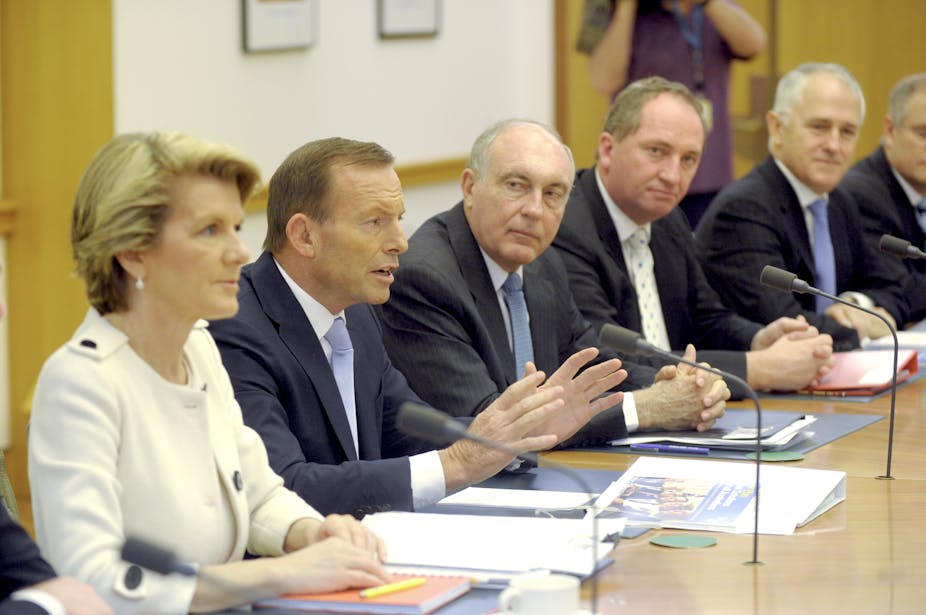Much has been made of the ‘unusual’ nature of the minority Labor government over the past three years and there has been a sense that Australia is better off without it; that we need a return to the stability of majority government. But we have had numerous minority governments in Australia and they generally don’t raise an eyebrow.
Should Tony Abbott be elected on Saturday, he will likely join a long list of Liberal Prime Ministers who have led minority governments. Only a handful of elections has delivered the Liberal Party sufficient votes to govern in its own right.
Although the Coalition tends to be regarded as a single entity, it is worth remembering that it is in fact two distinct parties with their own constituencies. The Nationals frequently find themselves in a balance of power position in which their support could provide either Labor or the Liberals with the numbers to form government.
A question of distaste
It is therefore one of the anomalies of contemporary Australian political debate that minority government has been regarded with a degree of public distaste.
When Julia Gillard entered an agreement with the regional independents, responding to their needs in order to form government, her efforts were met with accusations of rent seeking and grubby deal-making.
When the Liberal Party offers sweeteners to the National Party with respect to the same constituency, rural Australia, there is nary a comment.
In Western Australia in 2008, the Nationals recognised their bargaining power and, although they ended up with the Liberals, they did go into the election as an independent entity with their own policy platform and a preparedness to bargain with both sides of politics. They were rewarded with the Royalties for Regions funding.
The WA case was an exception. The two parties usually go into an election campaign with a single voice but this does not detract from the fact that they have different policy emphases.
This is unremarkable as they are appealing to different constituencies. But it is not clear prior to an election how these differing priorities will play out if the Coalition wins government.
Trade and foreign investment
The issue of the foreign ownership of agricultural land is a case in point. The Nationals have long been concerned about foreign investors’ purchase of prime agricultural land; Barnaby Joyce has been particularly vocal on this issue, calling for a tightening of the national interest test.
The Nationals policy calls for a register of foreign ownership of land and agribusiness, as well as a lowering of the threshold for the national interest test’s application by the Foreign Investment Review Board, from $244 million to $15 million.
When this issue was raised at the Leaders’ debate at Rooty Hill last week, Abbott was reportedly circumspect, possibly reflecting the nervousness in his own party on this issue. This position was of course in contrast to Kevin Rudd, who appeared to be developing Labor’s policy on this issue on the run.
When the Nats have been previously in government, they have secured the Cabinet portfolios of most interest to their constituency: agriculture, trade, regional development and transport.
Breaking with tradition
There is now a strong suggestion that an Abbott-led Coalition would break with tradition and allocate the trade portfolio to a Liberal Minister to pursue a vigorous free trade and foreign investment agenda, which is somewhat at odds with the Nationals push for tightening up the national interest test.
It is worth noting that some of the most strident disagreements between the Coalition partners in the past have been over trade-related issues: the devaluation of the Australian pound in the 1960s, tariff policy (on more than one occasion), export wheat marketing and so on.
The Australian Coalition arrangement is, by comparison with other political systems, an oddity. It is set apart from coalitions elsewhere by its ongoing nature, even in opposition, and the fact that the parties go into elections with a common election platform.
However, the fact remains that the parties are different and in the past have disagreed on a number of key policy issues; the National Party has even vetoed the selection of two Liberal leaders as Prime Minister.
It would be a mistake to extrapolate from the apparent unity going into an election to assured unity on every issue in government.
It should also be remembered that, in minority government, the junior partner has some leverage over policy, whether it exercises that leverage in a written agreement negotiated publicly or in Cabinet negotiations behind closed doors.

